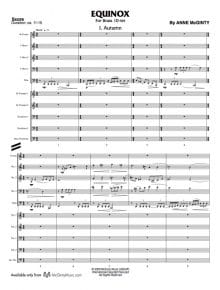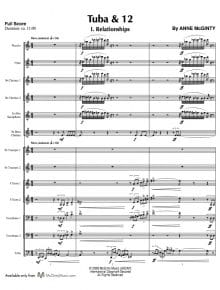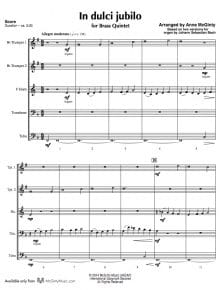Search Music
Music Categories
PDF Download Only
Purchase. Print. Play.
-
Equinox – Large Brass Ensemble
Equal day, equal night, represented by double brass quintet, conical vs. cylindrical. Seating should be in an inverted V, with tuba on the outside left. Going up the left side, next to tuba is horn 3, then horn 2, horn 1 and cornet at the top of the inverted V. Coming down the right side is trumpet 1 at the top, trumpet 2, trombone 1, trombone 2 and bass trombone, facing tuba.
Brilliantly crafted to maximize the different timbres, the wide ranges and varying instrumental combinations, this is an impressive achievement accomplished with great skill and a welcome addition to the brass repertoire.
The sample score and mp3 excerpt include all three movements.
Total duration: ca. 11:15
I – Autumn (3:47)
II – In-between (3:45)
III – Spring (3:40)
Performers:David Wailes – Cornet
Andrew Pelletier – Horn
Jenny Kim – Horn
Bruce Hudson – Horn
Doug Tornquist – Tuba
Marissa Benedict – Trumpet
Larry Hall – Trumpet
Alex Iles – Trombone
Philip Keen – Trombone
Bill Reichenbach – Bass TromboneComposer: Anne McGinty
Instrumentation: Bb Cornet, 3 F Horns, Tuba, 2 Bb Trumpets, 2 Trombones & Bass Trombone
Duration/# of Pages: ca. 11:15 / 54 pages, 8.5″ x 11″
Key: N/A -
Tuba & 12 – Mixed Large Ensemble
Tuba & 12 was inspired by a Bedouin proverb that states: “While the words are yet unspoken, you are master of them; when once they are spoken, they are master of you.”
Proverbs, in general, state a general piece of advice. This piece assumed that words were spoken, resulting in tension and an apology. Relationships, the first movement, has brass vs. woodwinds, tonality vs. dissonance, duples vs. triplets, et al. as well as the synergy and cooperation among all. Unspoken Words is the second movement and the dissonant opening theme in the piccolo and flute is presented three times. The third movement is Resolution. Over a constant low pedal G, the horn ostinato adds tranquility as all the themes from the first two movements return in fragmented form, before all is finally resolved.
Although tuba has top billing in the title, each instrument is equally important.
The sample score shows the first page of each of the three movements. The complete recording is available for free.
Composer: Anne McGinty
Instrumentation: Piccolo, Flute, 2 Clarinets, Alto Saxophone, Bass Clarinet, 2 Trumpets, 2 Horns, 2 Trombones & Tuba
Duration/# of Pages: ca. 11:00 / 75 pages, 8.5″ x 11″
Key: N/A -
Timeless – Flute Choir
The past, present and future are combined in this flute choir, commissioned by Bruce Harrell to celebrate his love for his wife, Barbara. The past includes a madrigal by Giovanni Gabrieli and a brief excerpt from an Anton Bruckner motet. The present includes original music written to showcase the ensemble. The future, of course, remains unknown. Written for five C flutes, alto flute and bass flute, this will be a welcome addition to the flute choir repertoire.
The excerpt recording was taken from the premiere performance, performed at the Harrell’s home in a surprise concert for Barbara.
Composer: Anne McGinty
Instrumentation: 5 C Flutes, Alto Flute & Bass Flute
Duration/# of Pages: ca. 6:00 / 28 pages, 8.5″ x 11″
Key: N/A -
In dulci jubilo – Brass Quintet
In dulci jubilo is a traditional Christmas carol from the Middle Ages, first appearing in a manuscript dating from c.1400. It has been arranged by many composers, including Michael Praetorius in the 1600s, Buxtehude, Franz Liszt and Norman Dello Joio, to name just a few. An English translation from the original text that alternated Medieval German and Latin by J. M. Neale became known as Good Christian Men, Rejoice.
Johann Sebastian Bach wrote a choral version (BWV 368), and a double canon (BWV 608) and chorale prelude (BWV 729) for organ. There is also a chorale prelude for organ based on a naive cradle-song version that was once used in the mystery plays held in churches at Christmas time. Although attributed to Bach, the cradle-song version (BWV 751) has never been authenticated.
This arrangement includes two versions, playable as one piece or separately, and begins with the cradle-song style. The simplicity as well as the imitation in the tuba pedal is quite charming and rather unexpected when compared to Bach’s usual complexity. The second version is based on the chorale prelude for organ and is a traditional postlude for Christmas services.
In the Complete Organ Works of Johann Sebastian Bach, edited by Edouard Nies-Berger and Dr. Albert Schweitzer, they state that the harmonizations of chorales were not usually written out as the figured bass was enough. These editors also assumed that Bach had a reason and suggest that he wrote them for his own satisfaction or, more likely, for use with his pupils in the course of instruction in thorough-bass playing.
Composer: Anne McGinty
Instrumentation: 2 BbTrumpets, F Horn, Trombone & Tuba
Duration/# of Pages: ca. 3:20 / 22 pages, 8.5″ x 11″
Key: F




